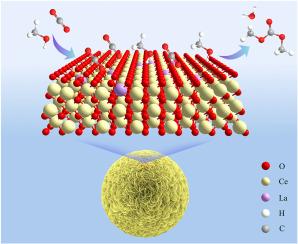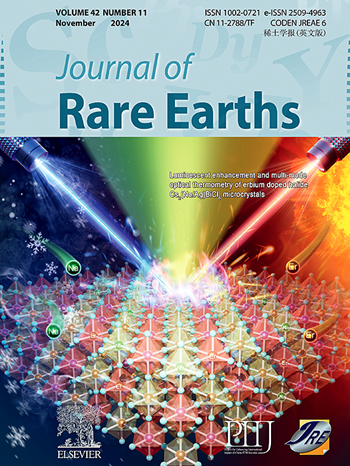la掺杂CeO2纳米花催化剂用于CO2和甲醇直接合成碳酸二甲酯
IF 7.2
1区 化学
Q1 CHEMISTRY, APPLIED
引用次数: 0
摘要
二氧化碳和甲醇催化直接合成碳酸二甲酯(DMC)是利用二氧化碳和生产高价值化学品的重要途径。然而,二氧化碳分子的高稳定性给这一反应途径带来了热力学限制,同时也带来了催化剂活性和稳定性不足的挑战。目前,解决方案主要集中在开发高效催化剂上。本文采用水热法合成了la掺杂的CeO2纳米花催化剂(LaxCeO2)。表征表明,La掺杂优化了孔隙结构,富集了氧空位,从而提高了催化性能。值得注意的是,La0.1CeO2具有最大的孔径和最高的氧空位含量,在140°C、4 MPa CO2和3 h的反应条件下,DMC产率达到了9.42 mmol/g,超过了纯CeO2纳米花。根据实验结果和现场漫反射红外傅里叶变换分析,提出了一种合理的反应途径。这项工作强调了LaxCeO2纳米花作为可持续的二氧化碳转化为DMC的有效催化剂的潜力。本文章由计算机程序翻译,如有差异,请以英文原文为准。

La-doped CeO2 nanoflowers catalysts for direct synthesis of dimethyl carbonate from CO2 and methanol
The catalytic direct synthesis of dimethyl carbonate (DMC) from CO2 and methanol is a crucial approach to utilizing CO2 and producing high-value chemicals. However, the high stability of the CO2 molecule imposes thermodynamic limitations on this reaction pathway, along with challenges related to insufficient catalyst activity and stability. Currently, solutions primarily focus on developing efficient catalyst. Herein, La-doped CeO2 nanoflower catalysts (LaxCeO2) were synthesized via hydrothermal method. Characterization reveals that La doping optimizes the pore structure and enriched oxygen vacancies, thereby enhancing catalytic performance. Notably, La0.1CeO2 exhibits the largest pore size and highest oxygen vacancy content, achieving a remarkable DMC productivity of 9.42 mmol/g under 140 °C, 4 MPa of CO2, and 3 h of reaction, surpassing pure CeO2 nanoflowers. Based on experimental findings and in-situ diffuse infrared Fourier transform analysis, a plausible reaction pathway was proposed. This work underscores the potential of LaxCeO2 nanoflowers as efficient catalysts for sustainable CO2 conversion to DMC.
求助全文
通过发布文献求助,成功后即可免费获取论文全文。
去求助
来源期刊

Journal of Rare Earths
化学-应用化学
CiteScore
8.70
自引率
14.30%
发文量
374
审稿时长
1.7 months
期刊介绍:
The Journal of Rare Earths reports studies on the 17 rare earth elements. It is a unique English-language learned journal that publishes works on various aspects of basic theory and applied science in the field of rare earths (RE). The journal accepts original high-quality original research papers and review articles with inventive content, and complete experimental data. It represents high academic standards and new progress in the RE field. Due to the advantage of abundant RE resources of China, the research on RE develops very actively, and papers on the latest progress in this field emerge every year. It is not only an important resource in which technicians publish and obtain their latest research results on RE, but also an important way of reflecting the updated progress in RE research field.
The Journal of Rare Earths covers all research and application of RE rare earths including spectroscopy, luminescence and phosphors, rare earth catalysis, magnetism and magnetic materials, advanced rare earth materials, RE chemistry & hydrometallurgy, RE metallography & pyrometallurgy, RE new materials, RE solid state physics & solid state chemistry, rare earth applications, RE analysis & test, RE geology & ore dressing, etc.
 求助内容:
求助内容: 应助结果提醒方式:
应助结果提醒方式:


